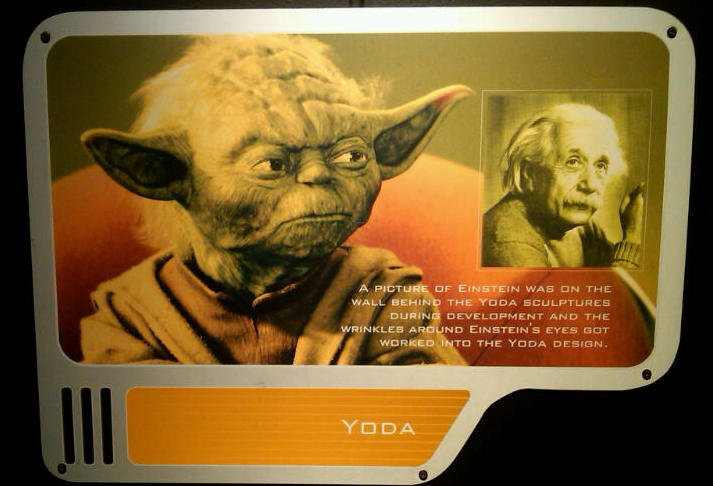
There is an old legend that Yoda, the Master Jedi in Star Wars was based on Spencer W. Kimball, who served as president of The Church of Jesus Christ of Latter-day Saints, from 1974 to 1985.

The comparison likely began as a joke, but over time the speculation gained traction in Latter-day Saint circles. However, the hypothesis has been denied by the people who worked on the film who clarified that the true inspiration for Yoda was Albert Einstein, as can be seen in the picture below.

George Lucas drew from several philosophies and religious traditions while making the films, including Zoroastrianism, Taoism, Buddhism, Manichaeism, and Stoicism.
However, Star Wars’ original producer, Gary Kurtz was a practicing Latter-day Saint. Kurtz, also produced American Graffiti in 1973, Star Wars and its sequel The Empire Strikes Back in 1977 and 1980, The Dark Crystal in 1982, and Return to Oz in 1985. For his work on Star Wars and American Graffiti, he was nominated for the Academy Award for Best Picture.
While the Star Wars franchise was influenced by many different philosophies and religious traditions, it also contains some similarities to Latter-day Saint theology that could have been influenced by Kurtz’s religious background. Some of these are:
THE FORCE

In Star Wars the spiritual power of the Force is an unseen energy that binds the galaxy together and that has to be felt rather than seen.
Much like a Jedi uses the mastery of the Force, Latter-day Saints believe that the priesthood is the power by which the earth and heavens were created, and therefore, a holder of that priesthood has power to heal the sick, raise the dead, and even move mountains, if this mighty work are approved by God.
Obi-wan Kenobi said that the Force “is what gives a Jedi his power. It’s an energy field created by all living things. It surrounds us and penetrates us; it binds the galaxy together.” We can compare that statement to the one made by President Gordon B. Hinckley about the priesthood in 1984: “There is no power on the earth like it. Its authority extends beyond life, through the veil of death, to the eternities ahead. It is everlasting in its consequences.”
The Force could be also compared to another Latter-day Saint concept—the Holy Ghost. As the Force can unify and guide the Jedi, similarly, the Spirit of the Lord, who is available to every human being who is baptized, can give constant guidance and protection.
POTENTIAL FOR GREATNESS

Star Wars, like Latter-day Saint theology, portrays mankind as infinitely greater than the fallen worlds on which we live. “Luminous beings are we,” said Yoda, “not this crude matter.” Of course, a central tenet of the gospel says that not only was God once a man like us but that we, through our Savior Jesus Christ as well as our own faith and desire, can eventually become divine. As the prophet Lorenzo Snow famously said, “As man now is, God once was. As God now is, man may be.”
President Dieter F. Uchtdorf recently spoke to the divine destiny of man. “There seems to be something inside of us that resists endings,” he said. “Why is this? Because we are made of the stuff of eternity. We are eternal beings, children of the almighty God, whose name is endless and who promises eternal blessings without number. Endings are not our destiny.”
FEAR VS. FAITH

Though not found in an episode Gary Kurtz produced, there is a famous Yoda quote: “Fear is the path to the dark side. Fear leads to anger. Anger leads to hate. Hate leads to suffering.” This advice famously led to (SPOILER ALERT!) the downfall of Anakin Skywalker and the creation of Darth Vader when it was not heeded. However, when it was heeded by his son, Luke, in episode six, it ultimately led to the overpowering of evil.
We hear often in the Church that faith is the antithesis of fear. Just remember the story of Peter walking on water! Elder Quentin L. Cook said in a 2007 conference talk, “When we choose to follow Christ in faith rather than choosing another path out of fear, we are blessed with a consequence that is consistent with our choice.” As Elder Cook points out, we’ve seen the consequences of fear, anger, and hate in our current world. But if we can choose to have faith and fight for the good, eventually Satan will no longer have power over us. (From the article Was Yoda Modeled After President Kimball?)
THE JEDI COUNCIL

The Jedi are also led by a council of 12 of the most experienced Jedi who meet together frequently and are also often traveling the galaxy. This may remind Latter-day Saints of the Quorum of the Twelve Apostles of the Church of Jesus Christ of Latter-day Saints. But in this case it may be improbable the influence of Kurtz, since the Jedi council wasn’t introduced until “Star Wars: The Phantom Menace” almost 20 years after Kurtz left the production. However, it still resonate with Latter-day Saints.
And though the specific similarities between the gospel and Star Wars go on and on throughout the series, the overarching similarity to Christianity is the most powerful gospel connection—a battle between good and evil where good will, eventually, triumph.
Why Are LDS Members and Authors so Interested in Science Fiction?
Perhaps there is something in the water, someone said, but it seems like a number of people have noted the success of LDS (Mormon) authors, particularly in the genre of science fiction and fantasy.
Mormons have won top honors in the otherworldly realms of sci-fi and fantasy since 1986, when Orson Scott Card’s novel “Ender’s Game” took both the Hugo and Nebula Awards. Card repeated that stunt a year later with “Speaker for the Dead.”

Other sci-fi and fantasy writers who are Mormon include Stephenie Meyer, Dave Wolverton, Tracy Hickman, M. Shayne Bell, Susan Kroupa, James Jordan and Virginia Baker.
Brigham Young University, the flagship LDS school in Provo, Utah, holds an annual academic symposium on science fiction and fantasy titled “Life, the Universe and Everything,” with offerings that range from workshops for wannabe sci-fi authors to scholarly presentations on the sci-fi genre. (From the article Mormons in space: Sci-fi or no lie?)
The “Battlestar Galactica” television series was also created by LDS church member Glen Larson, was built on a foundation of Mormon theology and cosmology.
Why LDS are so attracted to and even successful in writing science fiction?
Part of the answer lies in the theology of the Church. The Prophet Joseph Smith taught that God has “flesh and bones” and inhabits a physical place in the heavens.
“And worlds without number have I created,” God says in “The Pearl of Great Price,” which Latter-day Saints consider scripture.
Joseph Smith Smith also taught that human beings can progress to become divine, and this idea find its parallel in the science fiction theme of the progression of the human species.
More recently LDS church President Joseph Fielding Smith said that “We are not the only people that the Lord has created,” but “we have brothers and sisters on other earths. They look like us because they, too, are the children of God and were created in his image, for they are also his offspring.”
Another reason is that differently from other so called “conservative religions” there’s never been any fear of fantasy or science fiction among Mormons.
According to the “Faith and good works” article by boston.com, LDS authors are also drawn to the young adult genre for fantasy and science fiction to avoid the language and content found in contemporary adult fiction.
As was the case with Stephenie Meyer’s Twilight series, which did not contain any pre-marital sex despite it being a romantic fantasy novel.
There is also the appeal themes of spiritual growth and good overcoming evil themes that complement Mormon values. (From: Why Mormon Authors Are Dominating Science Fiction and Fantasy Novels)
